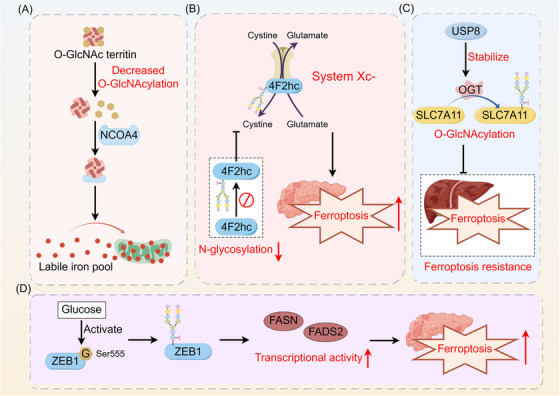FIGURE 5.

Role of glycosylation in tumor ferroptosis. Glycosylations interact with ferroptosis in cancer, modulating tumor progression. (A) Deglycosylation of the ferritin heavy chain enhances its interaction with the ferritin phagocytic receptor NCOA4, leading to the accumulation of unstable iron in mitochondria, which contributes to ferroptosis. (B) Inhibiting the N‐glycosylation of 4F2hc enhances the ferroptosis sensitivity of PDAC cells by suppressing the activity of the glutamate‐cystine reverse transport system Xc‐. (C) USP8 inhibits ferroptosis sensitivity in hepatocellular carcinoma by stabilizing OGT, which promotes the O‐GlcNAcylation of SLC7A11. (D) Glucose‐induced ZEB1 O‐GlcNAcylation activates the transcriptional activity of the adipogenesis‐related genes FASN and FADS2, leading to lipid peroxidation‐dependent ferroptosis in mesenchymal pancreatic cancer cells. Abbreviations: FADS2, fatty acid desaturase 2; FASN, fatty acid synthase; G, glycosylation; NCOA4, nuclear receptor coactivator 4; OGT, O‐GlcNAc transferase; PDAC, pancreatic ductal adenocarcinoma; SLC7A11, solute carrier family 7a member 11; USP18, ubiquitin‐specific peptidase 18; ZEB1, zinc finger E‐box binding homeobox 1.
